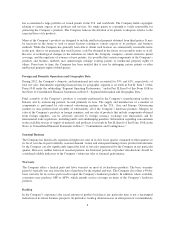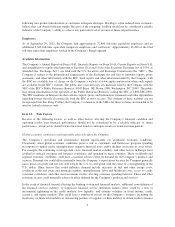Apple 2012 Annual Report Download - page 19
Download and view the complete annual report
Please find page 19 of the 2012 Apple annual report below. You can navigate through the pages in the report by either clicking on the pages listed below, or by using the keyword search tool below to find specific information within the annual report.indirect sales through its channel partners. In addition, the Company’s gross margin and operating margin
percentages, as well as overall profitability, may be materially adversely impacted as a result of a shift in
product, geographic or channel mix, new products, component cost increases, strengthening U.S. dollar, or price
competition. The Company has typically experienced higher net sales in the first fiscal quarter compared to other
fiscal quarters due in part to holiday seasonal demand. Actual and anticipated timing of new product
introductions by the Company can also significantly impact the level of net sales experienced by the Company in
any particular quarter. The Company could be subject to unexpected developments late in a quarter, such as
lower-than-anticipated demand for the Company’s products, issues with new product introductions, an internal
systems failure, or failure of one of the Company’s logistics, components supply, or manufacturing partners.
The Company’s stock price is subject to volatility.
The Company’s stock continues to experience substantial price volatility. Additionally, the Company, the
technology industry, and the stock market as a whole have experienced extreme stock price and volume
fluctuations that have affected stock prices in ways that may have been unrelated to these companies’ operating
performance. The Company believes its stock price reflects high future growth and profitability expectations. If
the Company fails to meet these expectations its stock price may significantly decline, which could have a
material adverse impact on investor confidence and employee retention.
The Company’s business is subject to the risks of international operations.
The Company derives a significant portion of its revenue and earnings from its international operations.
Compliance with applicable U.S. and foreign laws and regulations, such as import and export requirements, anti-
corruption laws, tax laws, foreign exchange controls and cash repatriation restrictions, data privacy requirements,
environmental laws, labor laws, and anti-competition regulations, increases the costs of doing business in foreign
jurisdictions. Although the Company has implemented policies and procedures to comply with these laws and
regulations, a violation by the Company’s employees, contractors, or agents could nevertheless occur.
The Company also could be significantly affected by other risks associated with international activities including,
but not limited to, economic and labor conditions, increased duties, taxes and other costs, political instability, and
changes in the value of the U.S. dollar versus local currencies. Margins on sales of the Company’s products in
foreign countries, and on sales of products that include components obtained from foreign suppliers, could be
materially adversely affected by foreign currency exchange rate fluctuations and by international trade
regulations, including duties, tariffs and antidumping penalties. The Company is also exposed to credit and
collectability risk on its trade receivables with customers in certain international markets. There can be no
assurance the Company can effectively limit its credit risk and avoid losses.
The Company’s primary exposure to movements in foreign currency exchange rates relates to non-U.S. dollar
denominated sales and operating expenses worldwide. For example, the uncertainty regarding the ability of
certain European countries to continue to service their sovereign debt obligations and the related financial
restructuring efforts by European governments may cause the value of several European currencies, including the
euro, to fluctuate, which could adversely affect the Company’s non-U.S. dollar sales and operating expenses in
the impacted jurisdictions. Weakening of foreign currencies relative to the U.S. dollar adversely affects the U.S.
dollar value of the Company’s foreign currency-denominated sales and earnings, and generally leads the
Company to raise international pricing, potentially reducing demand for the Company’s products. In some
circumstances, for competitive or other reasons, the Company may decide not to raise local prices to fully offset
the dollar’s strengthening, or at all, which would adversely affect the U.S. dollar value of the Company’s foreign
currency denominated sales and earnings. Conversely, a strengthening of foreign currencies relative to the U.S.
dollar, while generally beneficial to the Company’s foreign currency-denominated sales and earnings, could
cause the Company to reduce international pricing and incur losses on its foreign currency derivative
instruments, thereby limiting the benefit. Additionally, strengthening of foreign currencies may also increase the
Company’s cost of product components denominated in those currencies, thus adversely affecting gross margins.
18
























